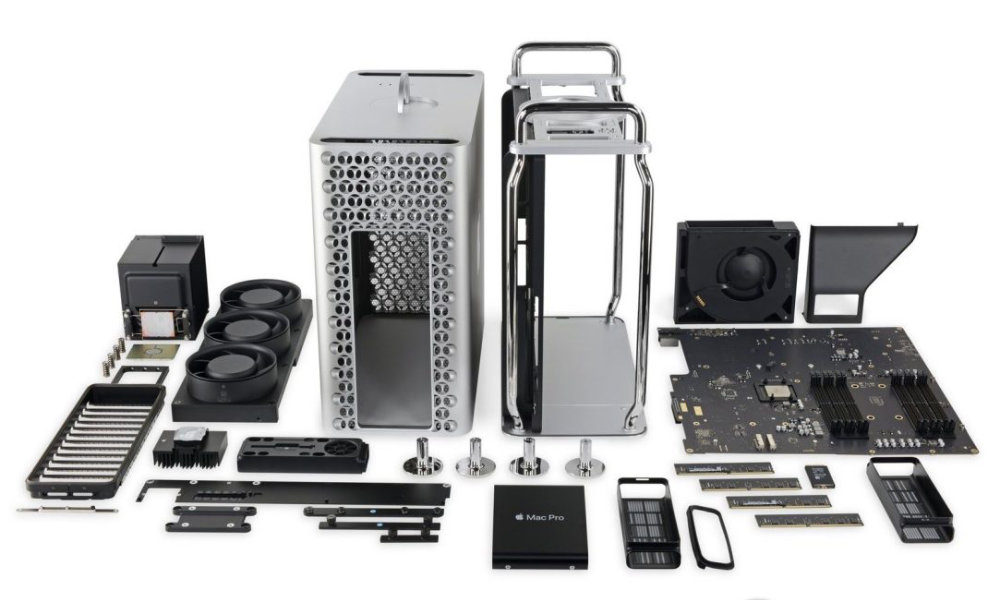iFixit Declares Apple’s New Mac Pro a ‘Fixmas Miracle’
 Credit: iFixit
Credit: iFixitToggle Dark Mode
Due to its focus on elegant industrial design, Apple hasn’t had the best track record when it comes to making its products easily repairable or accessible for upgrades, and it’s a trend that’s only gotten worse over the years as Apple has continued to try and pack more technology into increasingly smaller and thinner products.
Nowhere is Apple more castigated for this than by repair and DIY enthusiast site iFixit, which routinely tears down all of Apple’s latest products, from MacBooks to AirPods, commenting on how easy they are to get into, and to repair, and to upgrade, and when all is said and done, assigning a score for the “Repairability” of each product.
Apple’s new Mac Pro looked like it would be a breath of fresh air in this regard, since one of the primary foci of the machine was a modular design that would allow for easy upgrades, discarding the “trash can” Mac Pro design of 2013 and returning to the much earlier and more traditional tower construction of yesteryear.
iFixit put the Mac Pro through its traditional teardown in order to find out, and by all reports it looks like the new Mac Pro exceeded even their expectations. Even though they described the Mac Pro as being “about as Apple as they come” in the end it turned out be what they called a “Fixmas miracle” that’s “beautifully and amazingly well put together” and a “masterclass in repairability.”
No Complex Tools Required
Unlike many of Apple’s products, which use uncommon “pentalobe” screws and lots of glue, the Mac Pro is about as easy to get into as you’d expect from a tower, if not more so. Many of the hardware components don’t require tools at all, and the few places where you’ll need to pull out a tool, you’ll find that only the universally accepted Philips screwdriver is required in most cases.
Not only can PCI express cards easily be swapped in and out, and RAM upgraded, but even the CPU is replaceable. It takes more effort to get to it, but with replacement multi-core CPUs available for a lot less than Apple’s charging, it’s almost certainly worth it.
Other major components inside the new Mac Pro also use industry-standard sockets and interfaces, so there’s almost nothing proprietary here. The only notable and somewhat weird exception seems to be the SSD, which although modular has Apple’s T2 security chip bound to it, which means users will still have to go back to Apple to get SSD upgrades or replacements done.
To be fair, though, since the T2 also handles SSD encryption, it’s difficult to see how Apple could handle this in any other way without compromising security. It’s also worth keeping in mind that this only affects the primary SSD — the boot volume — so there’s nothing that prevents adding more SSD storage, and of course there are a wealth of ports for external Thunderbolt 3 storage arrays, so it’s really not that much of a negative.
Feet or Wheels?
Apple ships the Mac Pro with feet as the standard option, but allows users to swap those out for wheels for an extra $400. If you order your Mac Pro with feet but want to change to wheels later, Apple’s official answer is that you’ll need to haul it back to an Apple Store, pay for the upgrade, and let trained professionals make the switch.
However, iFixit found that while it’s tricky to get the feet off, it’s actually not impossible, adding that each one is only held in place with a single screw. The screws are buried deep inside slots in the frame pillars, so they’re awkward to access, but it’s probably worth it to save $400 if you can add your own DIY wheels.
The Final Verdict
In the end, iFixit gave the new Mac Pro a repairability score of 9 out of 10, which is by far the highest score an Apple product has gotten in over a decade. Not only is everything really easy to get into, with few to no tools required and industry-standard sockets and interfaces, but Apple even provides some diagrams right on the device and publishes free repair manuals.
What held the Mac Pro back from a perfect score, however, was the custom-made SSD cards that are bonded to the T2 chip, meaning that these can’t be universally swapped out, along with the fact that replacement parts that aren’t on Apple’s limited list of approved repairs can be “dizzyingly” expensive — if you can find them at all.
Still, though, even iFixit notes that these are minor quibbles and declares that the Mac Pro is “without a doubt the most repairable Apple product in recent memory.”






